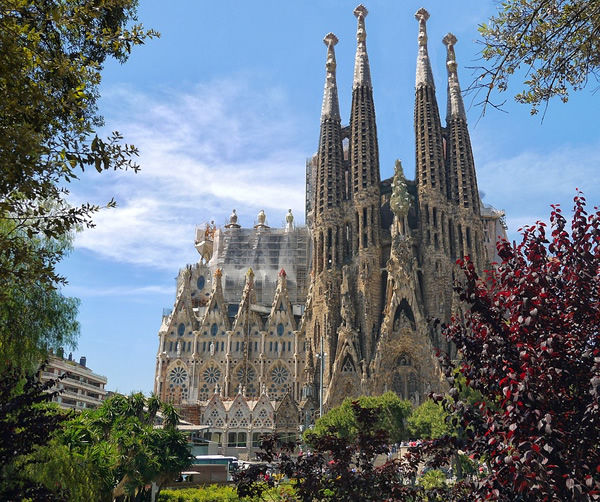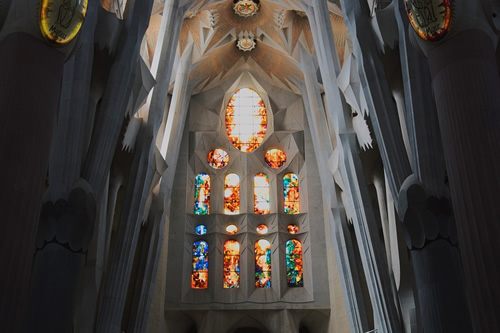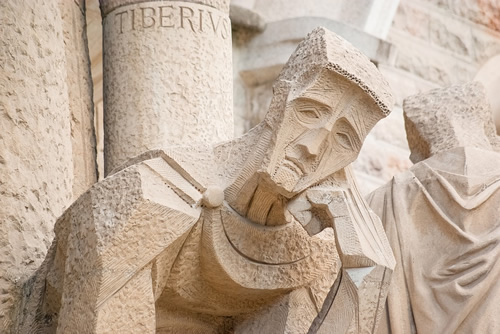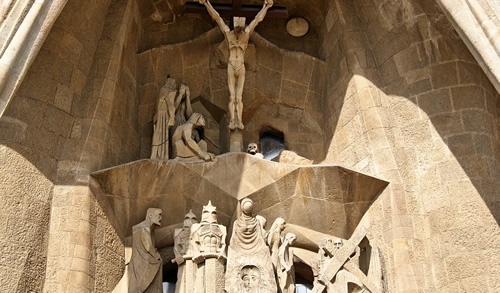La Sagrada Família in Barcelona
Antoni Gaudi's Sacred Church Is Finally Near Completion!
"My Client is in No Hurry"
By Isabel Eva Bohrer
5/30/2011 updated 2/20/2024 by Transitions Abroad

|
|
La Sagrada Familia construction is nearly complete even though the great architect had said: "My client is in no hurry."
|
Once Covered in Cranes and Surrounded by Scaffolding
There are monuments around which you plan your visit depending upon whether they are under construction or not. The La Sagrada Família church in Barcelona, however, has been been covered by cranes and scaffolding for quite some time now. So much so, that at this point the cranes were almost considered part of the church’s architecture; they even appear on numerous postcards as there was no other way building may be photographed. But to be fair to the genius, the genius architect Gaudí is attributed to have said that "My client is in no rush."
The great news, is the now final stages of the construction of the marvelous La Sagrada Familia church are near completion!
A Sacred and Magical Symbol of Barcelona
Even if you have never traveled to Barcelona, you have likely seen a picture of the Sagrada Família associated with the Catalan city. Over time, a church in the center of Barcelona has become a symbol of the city and Spain. Though it is most commonly associated with architect Antoni Gaudí (1852-1926), the construction began under the architect Francisco de Paula del Villar (1828-1901) on March 19th, 1882. At the end of 1883, Antoni Gaudí, Barcelona's architectural master, was commissioned to continue working on the church. Gaudí didn't stop working on La Sagrada Família until he died in 1926. Many architects have continued Gaudí's legacy, trying to finish the church according to his plans.
The Importance of Donations
Since its very outset, La Sagrada Família has been an expiatory church, meaning that donations pay for its construction. In Gaudí's words, "La Sagrada Família is made by the people and is mirrored in them. It is a work that is in the hands of God and the will of the people." Precisely because its construction depends on donations, it had long seemed far from completion. Now, at last, 2026 is the stated project termination date.

|
|
Nave of La Sagrada Familia.
|
From Traditional to Modern
In this day and age, we see powerful cranes used ubiquitously. But this was not always the case. When the church's construction began in 1882, the architects, the bricklayers, and other laborers worked using traditional methods. Gaudí, in turn, tried to take advantage of more modern techniques when he took over the direction in 1883. For example, he started using railway tracks with small wagons to transport materials from one place to another. He was also the first to bring in cranes to lift weights. Relocating the workshops to the actual site, another of his pioneering ideas, also made the construction easier.
Today's building techniques follow Gaudi's initial ideas and continue to bring in the safest, most comfortable, and fastest construction techniques. The powerful cranes that tower above the spires have replaced the old wagons. Similarly, the old (manual) tools have given way to more exact electric machines. The Church Technical Office and management oversee the completion of Gaudí's initial project, including the necessary calculations, building plans, and overall direction.
When you visit the church today, you can tour far more than the interior. Moreover, Part of the visit includes a museum where the church's history is well documented. You can even peer into the studio of the pedreros, meaning the masons that work on the stone carvings for the church to this day.

|
|
A statue on the facade of La Sagrada Familia.
|

|
|
Crucifixion scene on the facade.
|
The Construction Trajectory
Construction of the foundation began on March 19th, 1882, but the origins of the church date back to 1866. That year, Josep Maria Bocabellai Verdaguer founded the Spiritual Association of the Devotees of St Joseph, which promoted the construction of an expiatory church in honor of the Holy Family. One year before beginning the construction, this Association purchased a plot of land with a 12,800 m² surface area. The Carrer de Marina, Carrer de Provença, Carrer de Sardenya, and Carrer de Mallorca were to become the site's future.
Francisco de Paula del Villar y Lozano began by building the crypt beneath the apse following a neo-Gothic design. But soon after, the architect resigned (due to disagreements with the promoters), and this was when Antoni Gaudí became involved.
Gaudí and La Sagrada Família
Gaudí and La Sagrada Família
Shortly after taking over as architect, Gaudí finished the crypt and started working on the apse and the cloister. After 1889, he was given a large anonymous donation. Then, he came up with a new, more extensive work, discarding the neo-Gothic project of his architectural predecessor. Instead, he proposed a more monumental and innovative construction, including a Latin cross-ground plan and high towers. It was a project with important symbolism, both architecturally and sculpturally. The ultimate aim was to be a "catechistic explanation of the teachings of the Gospels and the Church."
After finishing the Nativity façade in 1892, the apse façade in 1894, and the Roser door in 1899, Gaudí built the Temporary Schools in 1909, designed for the children of the workers on La Sagrada Família and the local children who were members of its parish. One year later, the Grand Palais in Paris showed a model of the Nativity façade at an exhibition of Gaudí's work as a whole, promoted by his friend and patron Eusebi Güell, whose name you may have heard of in Association with Parc Güell, another of Barcelona's architectural highlights.

|
|
Nave of La Sagrada Familia.
|
After Gaudí
Upon Gaudí's death in 1926, Domènec Sugrañes, one of his close associates, took over the construction. Sugrañes worked on the site until 1938, when further master associates, including Francesc de Paula Quintana I Vidal, Isidre Puig I Boada, and Lluís Bonet I Garí, directed the construction until 1983. Subsequently, Francesc de Paula Cardoner i Blanch assumed the post of director, and most recently, Jordi Bonet i Armengol, who has occupied the post since 1984.
Destruction and Re-Construction of the Church
Unfortunately, the church's construction has not always been entirely seamless. July 1936 marked the time of a military uprising, specifically the Spanish Civil War outbreak. It was that very year that revolutionaries set fire to the crypt, and the Temporary Schools, as well as the workshop, were also destroyed. Nevertheless, the management is proud to say that the original plans of Gaudí continue to follow to this day.
Visiting Barcelona and the Sagrada Familia
A visit to the church is worth every instant, especially as the cranes and scaffolding disappear. As mentioned above, the Sagrada Família is located in the center of Barcelona and welcomes millions of tourists annually. You can buy just the ticket or the ticket along with an audio tour. You can book guided tours for individuals and groups if you wish, but that is unnecessary for most seasoned travelers, in our view. The opening hours and ticket purchases online are now conveniently available at Basílica de la Sagrada Familia schedule on tourist office website.
There, you can read more about visiting the church, including details on the accompanying museum, temporary and permanent exhibitions, and activities.
Isabel Eva Bohrer is the Director and Founder of ROOSTERGNN Global News Network, a non-profit news agency.
|
